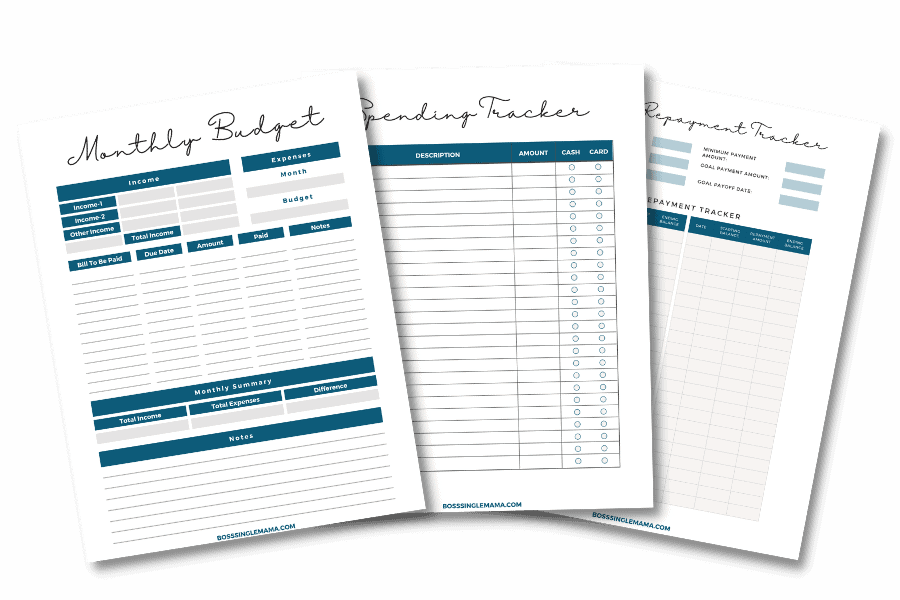Last Updated on September 7, 2023 by Rebecca Lake
Need to save some money for the holidays? Planning no spend November can help you set aside extra cash for holiday shopping, gifts, and travel.
If you’re not familiar with the concept, no spend November is a money-saving challenge. Specifically, you set a goal of not spending any money on unnecessary purchases for the entire month.
Doing a November no-spend challenge could help you save big ahead of the peak holiday shopping season. Today, we’re breaking down the no spend November rules to help you decide if this savings challenge is right for you.

LIKE FREE MONEY?
Here are some of my go-to apps for earning extra cash!
Survey Junkie. Earn up to $50 per survey just for sharing your opinions.
Swagbucks. Make money by playing games and watching videos. Join for free and get a $10 bonus when you sign up!
InboxDollars. Take surveys and get paid, no special skills or experience required!
Rakuten. Earn up to 40% cash back at hundreds of retailers, online or in stores. And get $30 for each person you refer, along with a $10 sign up bonus!
CashApp. Need a simple app for sending and receiving money? Get $5 free when you use code ‘VZXRXZN’ to join CashApp.
Table of Contents
What Is No Spend November?

No Spend November is when you challenge yourself to avoid spending money unnecessarily for the entire month of November. It’s another way of describing a spending diet or spending freeze.
A no spend November is all about being frugal and saving money during a season when advertisers are telling you to spend, spend, spend.
You can go on a spending diet any time of year, not just in November. For example, some people like to hit the pause button on spending in January after the holidays are over.
Doing a no-spend November is a great test your of money willpower because it seems like everyone is spending money at this time of year. It’s a great help if you need to get clear on the difference between wants and needs.
Here are some more ideas for money-saving challenges:
- Penny Savings Challenge
- 52-Week Savings Challenge
- How to Do the 50 Envelope Challenge (Printable Envelope Savings Challenge Tracker!)
- 200 Envelope Challenge (Save $5,100 in 200 Days!)
But do I really have to commit to not spending any money for the whole month?
Well, ideally yes.
This is the best way to squeeze the most savings possible out of a no spend month.
No Spend November Rules and Success Tips
The main thing to keep in mind when planning a no spend November is that the goal is to spend less. And you have to figure out what that means for you.
No spend challenges are designed to help you, not hurt you. At the end of the day, it’s up to you to decide what your challenge should look like.
Saving more money is great, especially if you’re trying to plan Christmas on a budget. But it’s more important to understand the ‘why’ behind what you’re doing and how that can help you change any bad financial habits that might be holding you back from getting ahead.
Ready to get started? Here are 10 no spend November rules for a successful savings challenge.
1. Decide what you will spend money on
A no spend November is all about being intentional with how you spend. So the first thing you have to do is separate your spending needs and wants.
For example, the things you have to spend money on might include:
- Mortgage or rent payments
- Electric, water and other utilities
- Gas and necessary transportation costs
- Groceries
- Internet and cell phone service
- Insurance premiums and out of pocket health care expenses
- Pet food and supplies
- Childcare if you and your spouse both work outside the home
- Debt payments
You might also include tithing here if that’s a regular part of your budget.
The way to put this list in perspective is to think about all the expenses you need to pay to maintain a basic standard of living.

Save More With Rocket Money
Stop overpaying and start saving!
Rocket Money is an all-in-one personal finance app that helps you find savings instantly, lower your bills, and keep more of your hard-earned cash.
It’s a simple way to build savings back into your budget every month, without getting nickel and dimed.
2. Decide what you won’t spend money on
Once you’ve got your most important expenses covered, it’s time to do the real work. Here’s what you have to decide what you’re going to cut from your spending for the month of November.
That might include:
- Holiday shopping
- Dinner out
- Trips to the movies or other paid entertainment
- New clothes
- Non-essential personal care (like getting your hair or nails done)
- Travel
- Hobbies and recreation
- Non-essential extracurricular activities for kids
As you’re going through your expenses keep in mind that what you do or don’t include as essential spending is entirely up to you. So there may be some things on your must-have list that might be a “want” for someone else.
And that’s totally fine. But the more you can cut out, the more money you could save this fall.

3. Plan your budget
A budget is your guide for spending the money that you make. If you’re trying a no spend November or any no spend challenge, then a budget is a huge help.
Your budget for November should include:
- Your total expected income
- Each expense you plan to spend money on
- Any required debt payments you have to make
This budget should look considerably different from your regular month budget since you’re cutting out the nonessential stuff.
If you need a free budget worksheet to track your income and expenses, we’ve got one you can grab. Just enter your email address below to download the budget printables.

Take Control of Your Budget!
Grab these FREE budgeting printables and get your finances on track when you join the weekly newsletter!
4. Set a target for saving
If you’re not spending as much as usual in November, that should add up to some savings. But how much can you save with a no spend November?
It really depends on how much you can cut. And it might help you to come up with a savings target so that you’re more motivated to stick to your no spend plan.
For example, say your regular monthly budget is $4,000. Could you cut out $500 of that using a no spend challenge? $1,000? More?
This is where it’s really helpful to go over your expenses carefully before you get started with a no spend month. That way, you can have a savings goal to work toward.
5. Make a plan for your savings
Once you have a dollar amount you want to save, decide what it’s going to be used for.
For example, will you use it to pay for holiday purchases? Pay down debt? Add it to your emergency fund?
Giving those dollars a purpose helps you to make sure that once your spending ban is lifted, you don’t fritter that extra cash away.
It’s also important to think about where you’ll keep the money you’re saving.
For most people, it doesn’t make sense to save money if you’re not earning a great interest rate on it. That’s why I stick with online banks for savings accounts since they can offer much higher rates than brick-and-mortar banks.
If you’re looking for a new online banking option, Current is my go-to recommendation. Current pays great rates to savers without the steep fees other banks charge.

Grow Savings Faster With Current
Current is a digital banking app that makes it easy to grow savings, manage spending and track your goals in one place! You can set up individual savings pods for different goals and earn the same competitive APY for each one.
Aside from making saving a breeze, Current also comes with other great features like fee-free overdraft and access to 40,000+ ATMs!
**View product disclosures
6. Get your family onboard
If you’re planning to tackle a no spend month to get your family finances under control, then it has to be a family effort. Otherwise, it just won’t work.
So schedule a money meeting and lay down the ground rules for everyone about what you will and won’t spend money on. Talk to your kids about why you’re doing a spending fast and what the goal is.
You want this to be a positive thing for everybody so don’t let your kids assume that no spending equals no fun.
It just takes a little more creativity when you can’t spend money.
And if you need a little inspo, here are 50 fun fall activities you can do that cost little to no cash!

7. Plan ahead as much as possible.
Hopefully, you’re reading this post in October or even September, and not waiting until the last minute to try and plan a no spend November.
But regardless of how much (or how little) time you have to plan, make the most of it!
You can minimize your chances of having to spend money during by checking these items off your list:
- Plan your meals for the month and stock up the pantry ahead of time. (Try $5 Meal Plan for some super frugal meal planning ideas.)
- Purchase any necessary cleaning supplies you might need for the month.
- Pay up some or all of your bills in advance if you’re able to.
- Take your credit cards out of your wallet and consider switching to cash-only if you can.
- Plan out some ways to spend your time as a family that don’t cost money.
- Take care of any necessary clothing or personal hygiene purchases before the month starts.
The more you can plan ahead, the better.
But even if you’re reading this on November 1st (or later), just do what you can with the time you have.
Even small steps can make a big difference in cutting down what you spend!

Need help with meal planning?
$5 Meal Plan is a weekly meal planning and prep tool that can help you save money and time in the kitchen. For just $5 per month, you can get a made-to-order meal plan to feed your family for less than $2 per person, per meal!
8. Track your spending
Sticking with a no spend challenge is tough and you need a way to stay accountable as a family. An easy way to do that is to track your spending.
There’s no right or wrong way to do it.
You can use a budgeting app that links to your debit card to record purchases, record it in an expense tracking spreadsheet or just write it down in a notebook.
The point is to keep a running tab on what you spend to make sure you’re staying within those boundaries you set for yourself way back in step one.
Looking for a simple money management tool? Empower makes it easy to track spending, saving, investing, and budgeting in one place so you can tackle your financial goals!
9. Resist temptation

A no spend month, whether it’s in November or any other time, isn’t always easy. And when there are sales everywhere, it’s so hard to just say no to spending!
But here’s something I want you to remember. You don’t have to spend.
Really. I mean it. Just because your favorite store is running a super-awesome-amazing-can’t-pass-this-up deal doesn’t mean you have to buy something.
So, here are some of my best tips for resisting temptation:
- Unsubscribe from your favorite stores’ email lists so you’re not bombarded with sale ads.
- Take a break from watching TV. No TV = no commercials trying to lure you into breaking your no spend vow.
- Tell people you’re doing a no spend November and say “no, thanks” to friendly invitations that could lead to spending.
- Toss the sale papers that come in the mail in the trash. (Or better yet, find a way to repurpose them.)
- Turn off notifications from shopping apps or websites.
If you need some help staying on track, give yourself some motivation.
Create a money mantra as a reminder of how much you want to save. Promise yourself that once the no spend month is up, you’ll enjoy a small, frugal treat.
Bottom line, give yourself something to look forward to so that you have a reason to keep going.
And if you do have to shop, don’t pay full price.
Using an app like Rakuten can help you earn back some of what you spend, so that you’re saving money all the time. I’ve earned close to $1,500 in cash with Rakuten and it’s a super simple way to save on shopping.

Want to Get Cash Back When You Shop?
Making extra money is easy with Rakuten!
Rakuten is a free app and browser extension that helps you find coupons and discounts when you shop online or in stores. You can earn up to 40% cashback when you shop at hundreds of partner retailers, plus get a $10 sign-up bonus and up to $30 in bonus cash for each person you refer!
10. Leave room for the unexpected
Sometimes, life happens. And when it does, that might require you to spend money.
November and the holiday season, in general, can get hectic. A few Novembers ago, I had to spend $5,500 to replace my HVAC system two days before Thanksgiving. Super fun.
So yeah, I get that things might not always work out the way you planned. But you can make any bumps you might run into smoother by being prepared.
The best way to do that is by having some cash savings you can draw on just in case. Even if it’s just a few hundred dollars, that could help you avoid having to pull out a credit card to pay for an unplanned expense.
Make Extra Money for the Holidays
Starting a fall side hustle is a great way to boost your no spend November savings. More money coming in means more cash you can stash in a savings account!
You could use that money to pay for holiday shopping, get ahead on bills or pay off some debts before the new year gets underway.
Not sure what you can do to make extra money in the fall? Check out these posts to help you get started with a money-making side hustle!
- How to Make $2000 a Month From Home With Flexible Side Hustles
- 50+ High-Paying Side Hustles for Moms Who Want to Make Extra Money
- 142 Legitimate Side Hustle Ideas to Make Extra Money
- How to Make 100 Dollars a Day Fast

Make Quick Cash With Survey Junkie
Take surveys. Earn rewards. Get paid.
Making extra money is that easy when you create an account with Survey Junkie. It’s free to sign up and you can earn real cash in your PayPal account or free gift cards, just for answering questions and sharing your opinions.
Final Thoughts
By now, you should be well on your way to planning a successful spending freeze for November. And once you get that first no spend month under your belt, you’ll be ready for the next one!
Ready to plan your Christmas budget? Learn how to make a Christmas budget step by step!

Comments are closed.